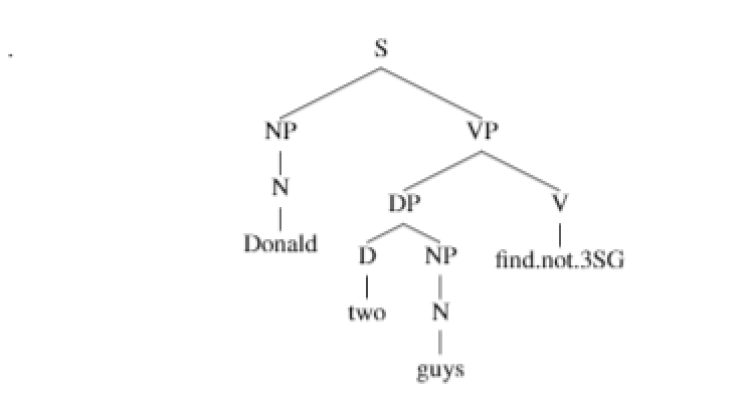Quantifier Scope Ambiguity in English and Turkish
Here's something you may not have realized about language. Sometimes a sentence can be ambiguous, and you won't even realize it!
By Kieran Britt
Course: Morphology and Syntax (Ling 4420)
Advisor: Jared Desjardins
LURA 2019
For example, the following sentence lends itself to two possible interpretations:
(1) Old men and women left the theater.
What does “old” modify in this sentence? “Men” or “men and women”? In other words, does the sentence refer to
(2) ‘old men and old women’
or
(3) ‘old men and women of any age’?
You probably prefer the reading in (2), though there may be contexts where you would choose (3). (1) is an example of a scope ambiguity. Scope, in layman’s terms, is the question of what parts of a sentence are modified by other parts of the sentence, in this case, determining what the adjective “old” modifies.
There are other sentences which are similar to the example above, in that they exhibit scope ambiguities. Example (4) is one such sentence:
(4) John didn’t find three guys.
You probably read this sentence to mean:
(5) John found something, but it wasn’t three guys. (Perhaps it was four guys, or three girls.)
But it’s possible that you could have read the sentence differently in a specific context. Perhaps if you knew John was playing hide and seek, and out of the ten people he was looking for, he found seven, in which case you might read it like this:
(6) There are three guys who John was looking for, who he didn’t find.
Similarly, if a third party had just said, “John found three guys” but you know that he found two, not three, you might say, “John didn’t find three guys. He found two,” and intend the first of the two readings (example 5). So it seems clear that both readings are viable, and your interpretation might depend on something outside of the sentence itself, such as context or your background knowledge about the world.
Sentences like (4) are called Quantifier Scope Ambiguities (QSAs). There are multiple types of QSA, but the one in example (4) arises when it isn’t clear whether a quantifier or a negating element takes scope over the other. In this case, the “not” in the contracted form “didn’t”, and the quantifier “three” are the competing parts of the sentence, because in the reading in (5), “not” takes scope over “three,” and in (6) “three” takes scope over “not.”
Now we know a bit about QSAs, but there is more to the tale. Sometimes the translation of an ambiguous sentence in one language will be unambiguous in another. Turkish is a language where, when compared to English, this can happen – sentences like example (1) are ambiguous in English but not in Turkish. I tried to figure out why, and I hypothesized that it was something having to do with the typology of Turkish: the way that Turkish expresses meaning through morphology (word formation) and syntax (word order). In order test my hypothesis, I analyzed Turkish QSAs and compared them to their English counterparts, hoping to find a causal link between some typological feature of Turkish and the lack of ambiguity of these kinds of sentences.
Take the following sentence:
(7) Donald didn’t find two guys.
Clearly, this sentence is ambiguous in the same sense as example (4). But the Turkish version of this sentence only has one reading: Donald found something, but it wasn’t two guys, analogous to the first reading of example (1). The alternative reading is not permitted.
(8) Donald iki çocuk bul-ma-dı.
Donald two child find-NEG-PAST
‘Donald didn’t find two guys.’
( ~(∃2x: x is a guy) (Donald found x); *(∃2x: x is a guy) ~(Donald found x))
It is interesting to note that the reading which is allowed corresponds to the syntax of the sentence, as shown in example (9). However, as Turkish is a language with very free word order, other orders are permissible, so it isn’t clear how meaningful this is.
(9)

However, if you add an accusative marker (which denotes the direct object of the sentence) to “two guys”, it marks for specificity, and you get the other reading. The reason for this seems to be an interaction between usually obligatory morphological markings and syntactic convention due to the free word order of Turkish. When the direct object of a sentence in Turkish is in its “normal” position (for example, in 8, directly preceding the verb), the usually obligatory accusative marker on the direct object becomes optional, and begins to mark for specificity. And curiously, this effect can be duplicated in English as well, via different means. In place of example (7), take the sentence:
(10) Donald didn’t find the two guys.
This sentence seems to permit only the reading where Donald was searching for two guys, and didn’t find them. This is because the ‘the’ in the sentence marks for specificity, by presupposing that there are two guys who are referenced. So, one conclusion we can draw is that specificity effects serve to disambiguate Quantifier Scope Ambiguous sentences, both in English and in Turkish.
There is another conclusion to be drawn from this example. Though in both English and Turkish specificity can disambiguate the readings, in Turkish, the sentence in (7) is unambiguously interpreted from the get-go. This isn’t fully understood, but my hypothesis is that, because of the free word-order of Turkish and because the marking of the direct object is morphological and optional (specifically when in the default position), the sentence has room to default to a given reading. This isn’t true of English, which must mark specificity with definite descriptions. Further research must be done to know if this is the correct explanation.


